Shivers is a concern for performance horses, especially those competing in sports like dressage that require fine motor control. There is no known origin, cure, or treatment. Those mysteries are what Dr. Stephanie Valberg, MSU Mary Anne McPhail Dressage Chair in Equine Sports Medicine, is trying to solve.
What is Shivers?
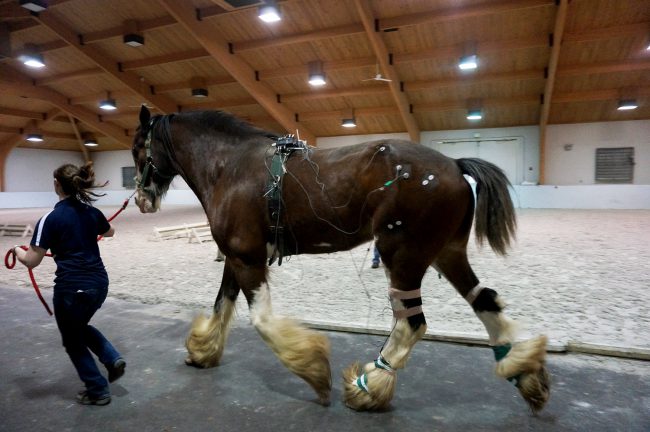
Shivers refers to a chronic neuromuscular syndrome in horses. The clinical signs vary in type and severity, but most commonly can be observed while the horse is backing up. The horse may exhibit hyperflexion, when one hind limb is raised up and away from the body in a spastic state, or hyperextension, when the horse places its hind feet further back than normal and shuffles backward. During this time, the horse can develop painful cramps and uncontrolled shaking, which can inhibit movement.
Shivers is nothing new–it has been recognized for centuries. But there was no consensus on what shivers actually was until 2015, when Dr. Valberg’s team published a paper describing specific types of shivers. After defining the clinical signs of the disorder, she began working with Dr. Anibal Armein to determine whether shivers might be due to cerebellar Purkinje cell axonal degeneration, or the breaking down of specific nerve fibers located in a part of the brain called the cerebellum. The cerebellum is the portion of the brain that controls motor function. Drs. Valberg and Armein determined that there is a connection between cerebellar degeneration and shivers. Now Valberg’s team is researching the possibility that shivers may be inherited.
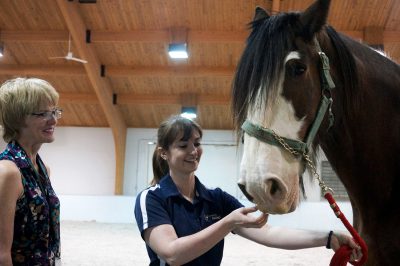
“We suspect, but do not yet know, if shivers is inherited,” Dr. Valberg said. “You may inherit a genetic mutation that makes you susceptible to a degenerative disease, and then if the right environment meets the right genetic susceptibility, the disease develops in those horses. We know that height and gender have a big impact on whether horses show signs of shivers. If they are under 16.3 hands tall or a female, they are much less likely to show signs of the disease. So you could inherit the genetic mutation, but it may not express itself if you are a female and short. But if you are a male and tall, it may become obvious. This really complicates finding the genetic basis for the disease.”
Teaming Up
Dr. Valberg’s current research is working to characterize electromyographic (EMG) hind limb muscle activity patterns in horses with shivering, and then correlate this with gait abnormalities and cerebellar degeneration. To explore this theory, Dr. Valberg is partnering with neurophysiologists Dr. Juergen Konzak and Dr. Joshua Aman to test the muscle recruitment pattern of a variety of horses with and without shivers. Dr. Aman is a post-doctoral associate in the Department of Neurology at the University of Minnesota. His research focuses on understanding how the human brain controls movement with a special focus on the causes and mechanisms of neurological diseases or injury that affect the motor and somatosensory systems. The somatosensory system is concerned with how pain, pressure, touch, temperature, movement, and vibration are perceived.
“Dr. Valberg came to us in the neuromechanics lab and asked us to evaluate horses,” said Dr. Aman. "Our intention was to evaluate the muscle activity and correlate that with the kinematics of the horse’s movement. So that’s what we did. We’re using surface EMG to evaluate specific muscles that the horse uses for its gait, and then we walk the horses forward and backward and try to evoke some of the problems that they see in shivers, and try to capture that muscle activity and correlate it with what we’ve seen in the horses and where the abnormalities are in the brain.”
The Process
This research was conducted May 12-14 at the MSU McPhail Equine Performance Center. Six draft horses–four of which were the control group–had a small amount of blood drawn for DNA testing. Valberg’s team shaved small patches of hair off each horse’s hind limbs and attached four sets of electrodes. The team then fastened a sensor to the horses’ hind feet. Data from the sensors and electrodes fed into a monitor harness and was sent to a computer system.
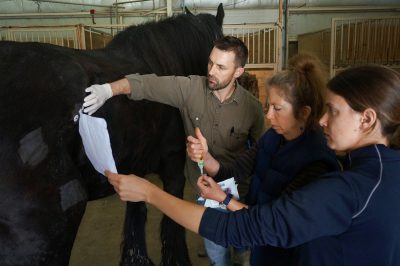
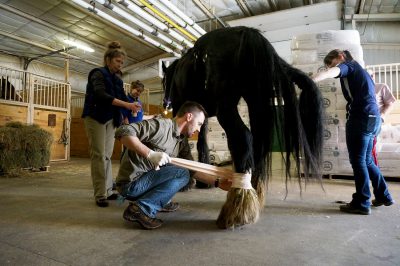
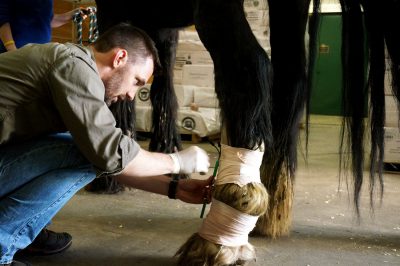
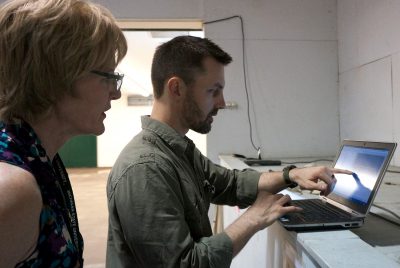
Drs. Valberg and Aman collected data during four key movements: when the horses lifted their hind limbs, walked backward, walked forward, and trotted. Each set of electrodes measured a different muscle. The data showed that the horses with shivers lost some degree of temporal precision in muscle firing. While in healthy horses, flexor muscles were active when extensor muscles were silent and vice versa, both flexor and extensor muscles fired at the same time in shivers horses, especially when they were walking backward.
“What this means is that for the first time, we know why a limb freezes and trembles in shivers horses. It is caused by abnormal firing of flexor and extensor muscles,” said Dr. Valberg. “We now know that the abnormal shivers gait occurs because the part of the brain that controls motor movement patterns (the cerebellum) has chronic degenerative changes. Knowing where in the brain the disease originates and how this lesion could cause clinical signs will help us focus our research into the cause of shivers. Treatments need to be developed based on the underlying disease process. We also plan to develop this EMG technique as a potential diagnostic test for shivers. Right now, there is no diagnostic test. It would be terrific if we could measure recruitment patterns to be able to more accurately diagnose shivers in horses.”
